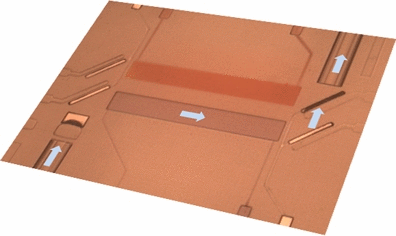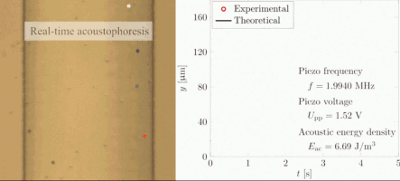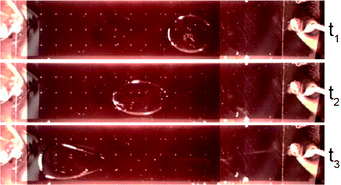 This Communication from Nathan B. Crane (University of South Florida) et al. describes new method of droplet transport, combining diode-like conduction and electrowetting on dielectric to achieve continuous electrowetting with a single electrode.
This Communication from Nathan B. Crane (University of South Florida) et al. describes new method of droplet transport, combining diode-like conduction and electrowetting on dielectric to achieve continuous electrowetting with a single electrode.
Continuous electrowetting via electrochemical diodes
Christopher W. Nelson, Corey M. Lynch and Nathan B. Crane
Lab Chip, 2011, 11, 2149-2152
DOI: 10.1039/C1LC20196D
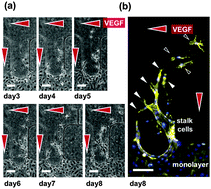 In their paper Seok Chung (Korea University) et al. have developed a hydrogel incorporating a microfluidic platform which can mimic the 3D tissue microenvironment for the study of endothelial cell sprouting angiogenesis. They are able to precisely control the gradient of soluble angiogenic factors, VEGF and ANG-1 and obtain a quantitative response to the assay.
In their paper Seok Chung (Korea University) et al. have developed a hydrogel incorporating a microfluidic platform which can mimic the 3D tissue microenvironment for the study of endothelial cell sprouting angiogenesis. They are able to precisely control the gradient of soluble angiogenic factors, VEGF and ANG-1 and obtain a quantitative response to the assay.
In vitro 3D collective sprouting angiogenesis under orchestrated ANG-1 and VEGF gradients
Yoojin Shin, Jessie S. Jeon, Sewoon Han, Gi-Seok Jung, Sehyun Shin, Sang-Hoon Lee, Ryo Sudo, Roger D. Kamm and Seok Chung
Lab Chip, 2011, 11, 2175-2181
DOI: 10.1039/C1LC20039A
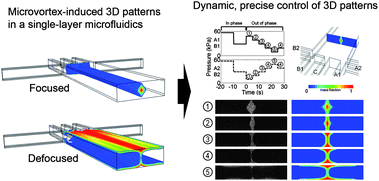 William C. Messner (Carnegie Mellon University) and colleagues have also been working in 3D to achieve dynamic control of 3D chemical patterns in a single 2D microfluidic platform. They are able to switch between ‘focused’ and ‘defocused’ 3D flow profiles, and to rapidly tune the patterns through feedback control of the inlet pressures.
William C. Messner (Carnegie Mellon University) and colleagues have also been working in 3D to achieve dynamic control of 3D chemical patterns in a single 2D microfluidic platform. They are able to switch between ‘focused’ and ‘defocused’ 3D flow profiles, and to rapidly tune the patterns through feedback control of the inlet pressures.
Dynamic control of 3D chemical profiles with a single 2D microfluidic platform
YongTae Kim, Sagar D. Joshi, Lance A. Davidson, Philip R. LeDuc and William C. Messner
Lab Chip, 2011, 11, 2182-2188
DOI: 10.1039/C1LC20077A
As with all our HOT papers, these are free to access for 4 weeks
 The purpose of this international workshop is to bring together researchers, technologists, entrepreneurs and funding bodies to interact in the multidisciplinary field of “Lab on Chip”, specifically aimed at biological and medical applications. All speakers are by invitation only. Ample opportunity for informal talks will also be provided, as delegates will stay at a centralised venue, and contributed posters can be presented. This workshop will focus on the following leading areas of “Lab on Chip” for bio applications:
The purpose of this international workshop is to bring together researchers, technologists, entrepreneurs and funding bodies to interact in the multidisciplinary field of “Lab on Chip”, specifically aimed at biological and medical applications. All speakers are by invitation only. Ample opportunity for informal talks will also be provided, as delegates will stay at a centralised venue, and contributed posters can be presented. This workshop will focus on the following leading areas of “Lab on Chip” for bio applications:










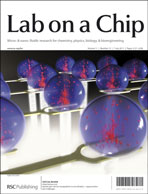 The striking image on the
The striking image on the 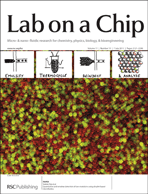 Quantitative and sensitive detection of rare mutations using droplet-based microfluidics
Quantitative and sensitive detection of rare mutations using droplet-based microfluidics This Communication from Nathan B. Crane (University of South Florida) et al. describes new method of droplet transport, combining diode-like conduction and electrowetting on dielectric to achieve continuous electrowetting with a single electrode.
This Communication from Nathan B. Crane (University of South Florida) et al. describes new method of droplet transport, combining diode-like conduction and electrowetting on dielectric to achieve continuous electrowetting with a single electrode. In their paper Seok Chung (Korea University) et al. have developed a hydrogel incorporating a microfluidic platform which can mimic the 3D tissue microenvironment for the study of endothelial cell sprouting angiogenesis. They are able to precisely control the gradient of soluble angiogenic factors, VEGF and ANG-1 and obtain a quantitative response to the assay.
In their paper Seok Chung (Korea University) et al. have developed a hydrogel incorporating a microfluidic platform which can mimic the 3D tissue microenvironment for the study of endothelial cell sprouting angiogenesis. They are able to precisely control the gradient of soluble angiogenic factors, VEGF and ANG-1 and obtain a quantitative response to the assay. William C. Messner (Carnegie Mellon University) and colleagues have also been working in 3D to achieve dynamic control of 3D chemical patterns in a single 2D microfluidic platform. They are able to switch between ‘focused’ and ‘defocused’ 3D flow profiles, and to rapidly tune the patterns through feedback control of the inlet pressures.
William C. Messner (Carnegie Mellon University) and colleagues have also been working in 3D to achieve dynamic control of 3D chemical patterns in a single 2D microfluidic platform. They are able to switch between ‘focused’ and ‘defocused’ 3D flow profiles, and to rapidly tune the patterns through feedback control of the inlet pressures.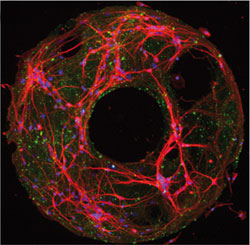 The recent LOC article from Henry Zeringue (University of Pittsburgh) and team has been highlighted on
The recent LOC article from Henry Zeringue (University of Pittsburgh) and team has been highlighted on 
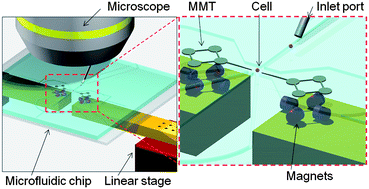 Manipulating cells in microfluidic chips is often accomplished with a magnetically driven microtool (MMT), driven by a permanent magnet. However MMTs driven by permanent magnets suffer from low positioning accuracy and response speed. Here, Masaya Hagiwara (
Manipulating cells in microfluidic chips is often accomplished with a magnetically driven microtool (MMT), driven by a permanent magnet. However MMTs driven by permanent magnets suffer from low positioning accuracy and response speed. Here, Masaya Hagiwara (
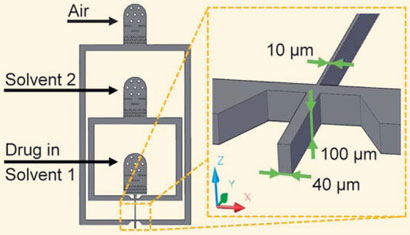 Over the last decade, the molecular complexity of drugs has increased significantly, leading to poor solubility, which means that the compounds can’t be used in the human body. To determine if new formulations have potential as successful drugs, solubility tests are run at an early stage of development. However, the amount of drug available for these tests is usually very small.
Over the last decade, the molecular complexity of drugs has increased significantly, leading to poor solubility, which means that the compounds can’t be used in the human body. To determine if new formulations have potential as successful drugs, solubility tests are run at an early stage of development. However, the amount of drug available for these tests is usually very small.